Recap of US Markets
STOCKS & OTHER INVESTMENTS
The Federal Reserve released its preliminary estimate for first quarter 2005 Flow of Funds on Thursday giving us a first look at this year's household balance sheet. Some of the results were not a surprise. For instance, after growing sharply (7.9 percent) in the fourth quarter of 2004, asset values on corporate equities and mutual funds fell 3.5 percent in the first quarter. In contrast, real estate asset values continued to grow at a solid pace, increasing 2.7 percent in the first quarter, after gaining 2.8 percent in the fourth quarter of last year.
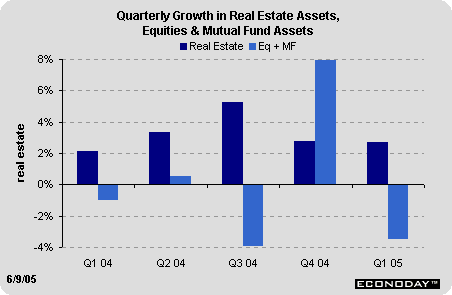
In order to accumulate real estate assets, households must take on mortgage debt. The question then becomes, are households taking on more debt than their assets are worth' In fact, the value of real estate assets grew slightly more (2.7 percent) than mortgage debt (2.2 percent). Given that many analysts are worried about a potential housing bubble (including Fed Chairman Alan Greenspan who warns of "froth" in some areas of the country) it is reassuring that real estate values are indeed rising faster than debt, particularly since so many homeowners have assumed interest-only loans lately in the hopes that they will gain equity in their homes without making principal payments. According to the latest Flow of Funds report, owners' equity as a percentage of household real estate assets inched up to 56.3 in the first quarter of 2005, from 56.1 in the fourth quarter. This percentage was higher in 2002 (56.8 percent) and higher still in 2000 and 2001 when it stood at 57.7 percent. Thus, homeowners have room for improvement to get back to where they were a few years ago.
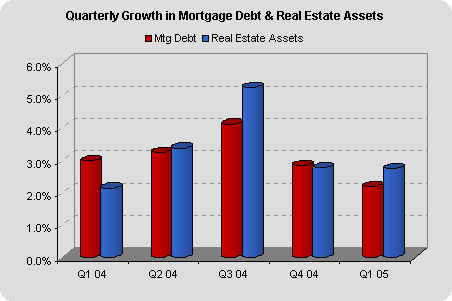
BONDS: WHY ARE YIELDS LOW'
Federal Reserve Chairman Alan Greenspan participated on a central bank panel discussion in Beijing (via satellite) this week where he addressed the hypotheses surrounding the conundrum of low and falling long bond yields in the face of Fed rate hikes. The yields depicted on the chart reflect those for July 1, 2004, the day after the Fed announced the first rate hike that brought the fed funds rate target to 1.25 percent, and yields posted on May 4, 2005, the day after the most recent Fed hike which brought the fed funds rate target to 3 percent. At the long end (10-year and 30-year), yields are lower today than they were a year ago. The 5-year note yield is only slightly higher (about 10 - 15 basis points) than it was a year ago, while the 2-year note yield is nearly one percentage point higher than a year ago.
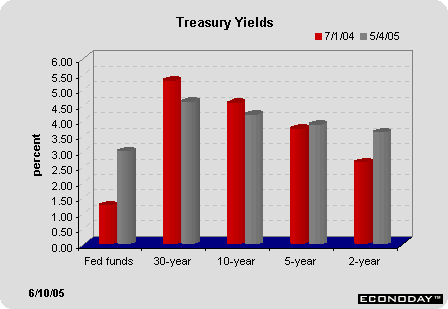
So what are the hypotheses suggested by Mr. Greenspan that explain this unusual phenomenon'
- In the past, low or declining long rates compared with short rates, which developed into a flattening yield curve, signaled a potential recession - or at least economic weakness. Greenspan downplays this possibility for now, even though he did conceded that it was "a credible notion." However, he feels that economic activity has shown "periods of buoyancy" over the past year while the long bond yield continued to drop.
- The second hypotheses that Greenspan addressed - and also discounted - focused on the behavior of pension funds. The baby boom population is nearing retirement age, but retirement plans are underfunded. This is causing many pension plans and insurance companies to increase significantly their long-term holdings. However, Greenspan noted that these demographic changes are not news - and are probably not large enough to change the yield curve structure on their own.
- Greenspan notes that foreign monetary authorities have rapidly accumulated U.S. Treasury obligations lately. And while he thinks that this demand for Treasury securities has lowered their yield, estimates by Fed researchers indicate that foreign bank accumulation is playing only a minor role in putting a lid on Treasury yields. Also, he points out, yields are low globally - and central bank purchases of U.S. Treasury securities would not necessarily explain the low long bond yields of non-U.S. sovereign debt.
- Finally, Greenspan considers the impact of the break-up of the Soviet Union along with the integration of China and India into the global marketplace. He believes that a greater integration of financial markets suggests that a greater share of the world's pool of savings crosses borders more readily.
None of these hypotheses totally satisfied the Fed chairman, and while they each may play a minor role in holding down long bond yields, he doesn't believe any are sufficient to explain the drop in yields. The conundrum remains unsolved.
And in the meantime, U.S. homeowners are benefiting from low mortgage rates that are really not any higher than they were before the Fed began to "remove policy accommodation." Thursday's remarks before the Joint Economic Committee indicated that Greenspan stands ready to continue to remove policy accommodation this summer. Although if long bond yields are de-coupled from Fed rate hikes, further rate hikes may not prevent further housing speculation because fixed rate mortgage loans are tied to long bonds, not the federal funds rate target.
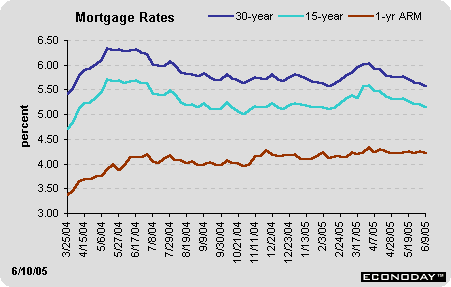
Markets at a Glance
Weekly percent change column reflects percent changes for all components except interest rates. Interest rate changes are reflected in simple differences.
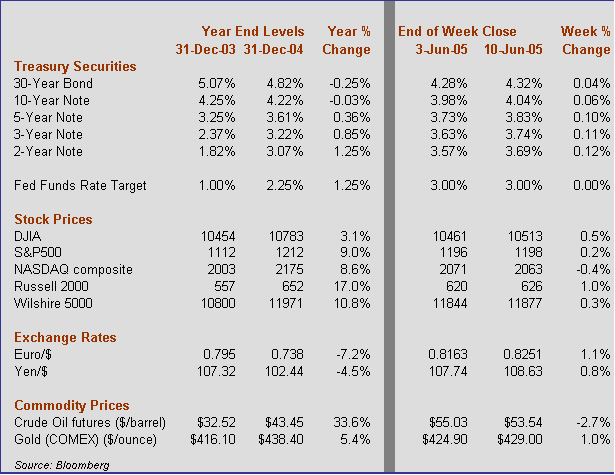
The Economy
International trade deficit widens again
The international trade deficit on goods and services widened by $2 billion in April to a $57 billion shortfall. Last month's deficit was revised to show a larger deficit than initially estimated, but still reflected a substantial drop from February's level. In April, exports increased a healthy 3 percent after rising 1.6 percent in March. In contrast, imports posted a 4.1 percent gain, but this offsets March's 3.1 percent drop. On a year-over-year basis, both exports and imports increased in April after moderating over the past few months.
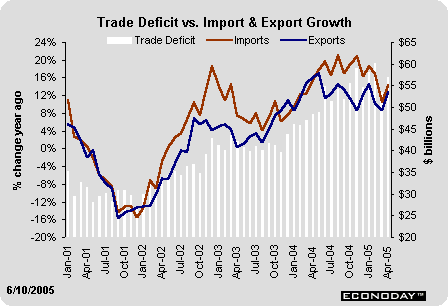
If the April deficit of $57 billion holds for the quarter, it would mean that net exports would be roughly unchanged from the first quarter pace - and it would mean that the foreign sector would not act as a sharp drag on GDP growth. However, most economists are expecting the trade deficit to worsen again in the next few months, so the April figures don't necessarily project a quarterly improvement.
Consumer credit moderates
Consumer installment credit grew only $1.3 billion in April, the smallest monthly rise since last November. Revolving credit declined for the second straight month while nonrevolving credit (including auto and boat loans) grew at the smallest pace since last November as well despite a 3.6 percent gain in motor vehicle sales during the month.

The Cambridge Consumer Credit Index, a survey that asks consumers about their intention to use credit in upcoming months, fell 6 points in June, and suggests that perhaps consumer installment credit will see less activity in upcoming months as well. Despite the June drop in the Cambridge Consumer Credit Index, levels are still higher than they were in June for the past couple of years, according to Allen Grommet, the economist who compiles the figures.
The Bottom Line
Economic news was sparse this week and market players monitored words spoken by Fed Chairman Alan Greenspan who commented on possible factors holding down long bond yields early in the week and on economic conditions at the end of the week. His earlier remarks were bullish for markets, but his economic testimony was pretty much in line with expectations and didn't lead to much excitement. Once again, he refused to name a neutral fed funds rate target, saying that the Fed would know "neutral" once he got there.
This upcoming week will see an abundance of economic indicators including several market moving indicators such as retail sales, the PPI and the CPI, housing starts, and industrial production.
Looking Ahead: Week of June 13 to June 17
Tuesday
Retail sales jumped 1.4 percent in April; excluding autos, sales also rose 1.1 percent. Domestic sales of motor vehicle sales fell 5 percent in May and this will surely dampen retail sales for the month. Gasoline prices have moderated lately, and this could help boost non-auto sales.
Retail sales Consensus Forecast for May 05: -0.2 percent
Range: -0.5 to 0.5 percent
Retail sales ex autos Consensus Forecast for May 05: 0.2 percent
Range: -0.2 to 0.5 percent
The producer price index increased 0.6 percent in April with a 2.1 percent hike in energy prices. Excluding food and energy, the PPI increased 0.3 percent for the month. Energy prices dipped in May, and this should dampen the total PPI figure.
PPI Consensus Forecast for May 05: -0.2 percent
Range: -0.5 to 0.3 percent
PPI ex food & energy Consensus Forecast for May 05: 0.2 percent
Range: 0.0 to 0.5 percent
Wednesday
The consumer price index increased 0.5 percent in April with a sharp 4.5 percent increase in energy prices. The core CPI was unchanged for the month. Gasoline prices dipped in May and this should curtail the total CPI gain for the month, although economists are looking for a slight acceleration in the core components.
CPI Consensus Forecast for May 05: 0.1 percent
Range: -0.1 to 0.2 percent
CPI ex food & energy Consensus Forecast for May 05: 0.2 percent
Range: 0.2 to 0.3 percent
The Empire State manufacturing index decreased in May to -11.1 from a low level of 2.0 in the month of April. If the index remains below zero in June, it points to further deterioration in manufacturing activity for the month.
Empire State index Consensus Forecast for June 05: 3
Range: -6.9 to 10
Business inventories increased 0.5 percent in March. In April, manufacturers' inventories inched up only 0.1 percent, but wholesale trade inventories jumped 0.8 percent.
Business inventories Consensus Forecast for Apr 05: 0.4 percent
Range: 0.2 to 0.8 percent
The index of industrial production dipped 0.2 percent in April. May might be a little stronger, but the average workweek and factory payrolls were anemic for the month. The market consensus is looking for a small rise.
Industrial production Consensus Forecast for May 05: 0.2 percent
Range: -0.2 to 0.4 percent
Capacity utilization rate Consensus Forecast for May 05: 79.2 percent
Range: 78.9 to 79.6 percent
The beige book will be closely monitored by market players to see if economic conditions are healthy in the retail sector, construction, and labor market and whether or not prices are accelerating.
Thursday
New jobless claims declined 21,000 in the week ended June 4 to 330,000. The four-week moving average decreased marginally to 331,750 for the week. May's average claim level was up 3.9 percent from April. It remains to be seen whether June claims will head lower again.
Jobless Claims Consensus Forecast for 6/12/05: 330,000 (unch)
Range: 324,000 to 335,000
Housing starts jumped 11 percent in April to a 2.038 million-unit rate. This followed a sharp drop in March. Mortgage rates have decreased lately despite Fed rate hikes, and this could still help the housing market.
Housing starts Consensus Forecast for May 05: 2.04 million-unit rate
Range: 1.9 to 2.16 million-unit rate
In contrast to the Empire State Survey, the Philadelphia Fed's business outlook survey moderated in May to 7.3 but it did not drop below zero. Still, it appears that manufacturing activity may be moderating in this Fed region.
Philadelphia Fed survey Consensus Forecast for June 05: 10
Range: 1.3 to 16
Friday
The University of Michigan's consumer sentiment index fell to 86.9 in May, posting the fifth straight monthly decline. Gasoline prices are no longer rising at exponential rates and this could help stem further declines in this index.
Consumer sentiment Consensus Forecast for mid-June 05: 88
Range: 84 to 90.5
The current account deficit widened sharply in the fourth quarter of 2004 to show a $187.9 billion shortfall. The international trade deficit widened only marginally in the first quarter of 2005 and this suggests that the current account deficit will deteriorate by a smaller amount than it did last quarter.
Current account Consensus Forecast for Q1 05: NA
Range: NA




